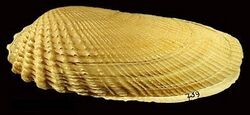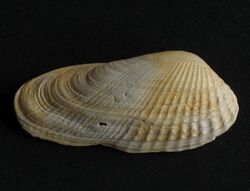Biology:False angelwing
| False angelwing | |
|---|---|

| |
| Paired valves of Petricolaria pholadiformis | |
| Scientific classification | |
| Domain: | Eukaryota |
| Kingdom: | Animalia |
| Phylum: | Mollusca |
| Class: | Bivalvia |
| Order: | Venerida |
| Superfamily: | Veneroidea |
| Family: | Veneridae |
| Genus: | Petricolaria |
| Species: | P. pholadiformis
|
| Binomial name | |
| Petricolaria pholadiformis (Lamarck, 1818)
| |
| Synonyms | |
|
Petricola pholadifomis Lamarck, 1818 | |
Petricolaria pholadiformis, common names false angelwing, or false angel wing (US), and American piddock (UK), is a species of saltwater clam, a marine bivalve mollusk in the family Veneridae, the Venus clams.
Description
Petricolaria pholadiformis closely resembles the angel wing (Cyrtopleura costata), the main distinguishing feature being that it lacks the apophyses, the spoon-shaped wings located near the beak, of the real angel wing. It grows to about 5 centimetres (2.0 in) long and is usually white. The anterior end is extended and has a rounded point while the posterior end is blunt and curved. There are ridges radiating from the beak, which are more pronounced at the posterior end, and fainter growth rings running parallel with the margin.[1]
Taxonomy
Petricolaria pholadiformis was formerly classified under genus Petricola as Petricola pholadiformis but has since been reclassified under genus Petricolaria.[2]
Distribution
Indigenous
This species is native to the Eastern Coast of North America including the Gulf of Mexico.[1]
Introduced
This clam was introduced and has become established in the British Isles and on the West Coast of North America.[3][4]
References
- ↑ 1.0 1.1 False Angel Wing: A Piddock for Your Thoughts Retrieved 2011-11-30.
- ↑ "WoRMS - World Register of Marine Species - Petricola pholadiformis Lamarck, 1818" (in en). http://www.marinespecies.org/aphia.php?p=taxdetails&id=140730.
- ↑ False Angelwing: Petricolaria pholadiformis Elkhorn Slough Research. Retrieved 2011-11-30.
- ↑ Petricolaria pholadiformis Marlin. Retrieved 2011-11-30.
Wikidata ☰ Q3806139 entry
 |




